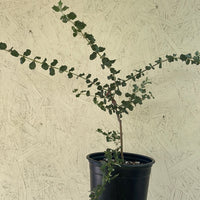

Ceanothus crassifolius, Hoaryleaf Ceanothus
Hoaryleaf Ceanothus
A California Native endemic to the Southern California mountains. It grows up to fourteen feet tall and ten feet wide. The white flowers bloom winter through spring. This plant is great for hedges, screens, shrubs, or can be trained to grow into a small tree.
Pinch and lightly prune in spring after flowering. You can remove flower clusters right after blooming to encourage a denser growth habit. If given too much water it will be short lived. You shouldn’t cut into any new growth that is larger around than a pencil. Larger cuts heal slowly and become infected with apricot dieback fungus, fungal spores are spread by rain.
An easy California Native to grow in the Los Angeles area.
- Plant in full sun to light shade
- Tolerates light pruning
- Tolerant of heavy clay and sandy soil, needs good drainage
- Water once a month after the first year
- Drought tolerant
- Attracts butterflies, bees, and birds
- Hardy up to 10 degrees
- Native to California
This content type will accept rich text to help with adding styles and links to additional pages or content. Use this to add supplementary information to help your buyers.
You can use product metafields to assign content to this tab that is unique to an individual product. Use tabs to highlight unique features, sizing information, or other sales information.
Hoaryleaf Ceanothus
A California Native endemic to the Southern California mountains. It grows up to fourteen feet tall and ten feet wide. The white flowers bloom winter through spring. This plant is great for hedges, screens, shrubs, or can be trained to grow into a small tree.
Pinch and lightly prune in spring after flowering. You can remove flower clusters right after blooming to encourage a denser growth habit. If given too much water it will be short lived. You shouldn’t cut into any new growth that is larger around than a pencil. Larger cuts heal slowly and become infected with apricot dieback fungus, fungal spores are spread by rain.
An easy California Native to grow in the Los Angeles area.
- Plant in full sun to light shade
- Tolerates light pruning
- Tolerant of heavy clay and sandy soil, needs good drainage
- Water once a month after the first year
- Drought tolerant
- Attracts butterflies, bees, and birds
- Hardy up to 10 degrees
- Native to California


